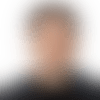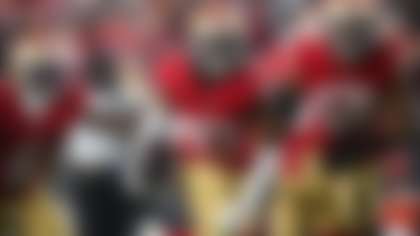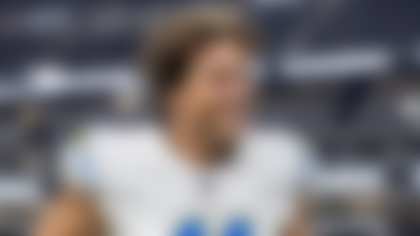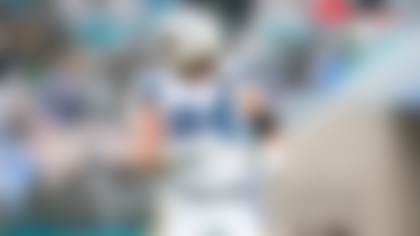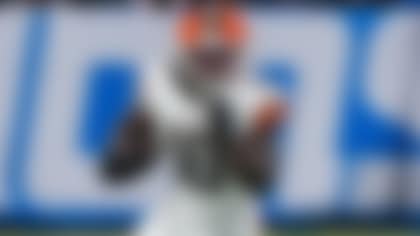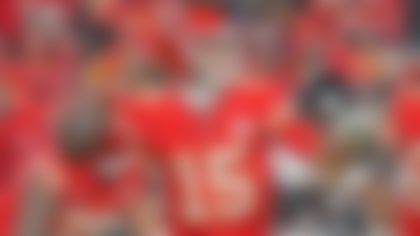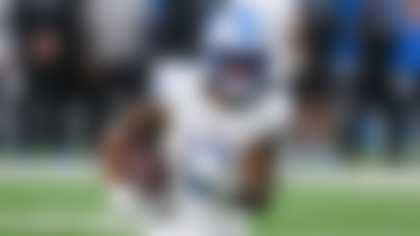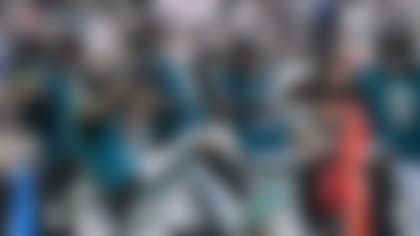Offseason stories are inevitably dominated by what's new: coaching changes, player acquisitions and draft picks. But the biggest area for growth on each roster comes from within. This week, I'll take a look at one homegrown talent from each team who could provide a huge boost by taking the next step in his development.
*For the purposes of this exercise, I'll only look at players on their rookie contracts that each organization needs to step up. After identifying a key player for AFC clubs on Wednesday, I've done the same for NFC teams on Thursday. Click through the tabs below to toggle between the AFC and NFC. *
Arizona Cardinals: D.J. Humphries, offensive tackle
Asking Sam Bradford or Josh Rosen to play behind the 2017 Cardinals offensive line would be a recipe for disaster. Last year's Cardinals squad only had Humphries at left tackle for five games before he suffered a dislocated kneecap, torn quad and torn medial patellofemoral ligament. The Cardinals picked up the fifth-year option in Humphries' rookie contract and have said they see him as their left tackle of the future, despite seeing him at the position for fewer than 400 snaps over three seasons. This will be an evaluation year for new Cardinals coach Steve Wilks and few evaluations will be more critical than the one to determine if Humphries is a core Cardinals player.
Atlanta Falcons: Takk McKinley, defensive end
McKinley rushes the passer like he rushed onto the NFL stage at the draft last year. His motor only cranked up more as his rookie season progressed, as he recorded sacks in each of his two playoff games. His energy can be felt at the top of the cheap seats.
After recording eight sacks on only 464 snaps last season, including the playoffs, McKinley could quickly become a premier pass rusher with a bigger workload. I'm a lot more confident in McKinley's ascent to star status than Vic Beasley's ability to recapture his 2016 form.
Carolina Panthers: Christian McCaffrey, running back
Anyone complaining about McCaffrey's rookie season after 1,086 yards from scrimmage and seven touchdowns should adjust their expectations. With that said, the ceiling to McCaffrey's career remains a big question heading into his second season. Is he going to be a rock-solid starter or is he going to be the type of superstar who was taken 33 picks ahead of Dalvin Cook and 59 picks ahead of Alvin Kamara for a reason?
I'm not sure how the marriage of Cam Newton and offensive coordinator Norv Turner will work, but the hire should work out great for McCaffrey. Turner knows how to get running backs the ball in space.
Chicago Bears: Leonard Floyd, outside linebacker
Defensive coordinator Vic Fangio knows that his defense appears to have everything on paper ... except edge rushers.
"There is a little bit of question there of depth and depth quality," Fangio said this week, per the Chicago Tribune. "But we are confident that the guys we have there, somebody will surface to be the two starters and couple of backups we need."
The group would look a lot different if Floyd made a DeMarcus Lawrence-type leap this season. The Bears traded up for Floyd in 2016 because of his rare ability to bend the edge. He flashed it as a rookie before a disappointing, injury-plagued second season. He could be the difference between a frisky Bears defense and a dominant Bears defense.
Dallas Cowboys: Chidobe Awuzie and Jourdan Lewis, cornerbacks
If you don't know the names above, you will soon enough because the Cowboys land on national television nearly every week. One of the likely early season storylines Al and Cris will discuss: Can the team's young secondary, led by these two second-year cornerbacks, hold up?
After shaking off hamstring injuries as rookies, Awuzie and Lewis quietly balled out as starters when paired together in December. Awuzie played with a scrappy, physical style that I want to see more of this season. The Cowboys feel the same way, installing him as the early starter on the outside opposite Byron Jones in OTAs.
Detroit Lions: Kenny Golladay, wide receiver
Much like his underrated teammate Marvin Jones, Golladay is a vertical threat with go-go gadget arms and a flair for posterizing cornerbacks in mid-flight. Jones led the NFL in yards per reception (18). If Golladay had qualified -- he caught 28 passes in 11 games -- he would have ranked fourth with 17 yards per catch. That is a silly tandem for opposing cornerbacks to deal with, especially with Golladay offering a level of physicality in the red zone that Jones lacks.
In what could be the final year for slot receiver Golden Tate in Detroit, the emergence of Golladay could take the sneaky fun Lions offense to another level.
Green Bay Packers: Aaron Jones, running back
Whether it was Ryan Grant or James Starks or even Eddie Lacy, Aaron Rodgers has been surrounded by fine runners who received a little too much credit for playing next to Aaron Rodgers. It would be nice to see Rodgers finally play with a back capable of making plays on his own, capable of making Rodgers look better.
That's a lot to ask of Jones, a fifth-round pick entering his second season who was healthy enough for only 81 carries over 12 games last season. But so many of those 81 carries indicated Jones could be up to the task, with his clear vision and propulsive burst.
Los Angeles Rams: Cory Littleton and Samson Ebukam, linebackers
The starry approach to the Rams' offseason had some less-discussed repercussions. After the team spent big on the secondary and the defensive line, general manager Les Snead turned over the linebacker group to young, unknown players.
Littleton, a third-year player who went undrafted in 2016, is getting the first crack at replacing middle linebacker Alec Ogletree. Ebukam is a 2017 fourth-round pick who looks locked into a starting edge-rusher job. In coordinator Wade Phillips' system, the mammoth defensive line and sticky secondary should make the linebackers look better, just like Tom Brady makes his running backs look better every year. It's the system. At least that's the plan, and it's up to Littleton and Ebukam to help make Snead look Belichickian with his strategic allocation of resources.
Minnesota Vikings: Anthony Barr, outside linebacker
Of all the great defensive draft picks during general manager Rick Spielman's tenure in Minnesota, Barr initially looked like The One. But it was Barr's former UCLA teammate Eric Kendricks who established himself as a team leader and earned that long-term coin first. Now, Stefon Diggs and Danielle Hunter, drafted a year after Barr, figure to be bigger priorities for Spielman when looking at contract extensions.
Barr has proven to be a versatile, talented starter who doesn't quite change games as much as his coaches expected. And that still has plenty of value. It's easy to imagine Barr making a contract push for the Super Bowl-contending Vikings, then cashing in huge in free agency next year.
New Orleans Saints: Sheldon Rankins, defensive tackle
Rankins took a big step in Year 2, improving his pass-rush efficiency while nearly tripling his snaps. He was forced to play out of position at defensive end at times, but is at his best disrupting from the interior. After a terrific performance in the team's playoff loss in Minnesota, there's hope that Rankins has another tier to climb. With first-round pick Marcus Davenport in the mix on the edge and Cameron Jordan at his career peak, this could be the best Saints defensive line in years if Rankins continues to develop.
New York Giants: Eli Apple, cornerback
For all the off-field drama created when safety Landon Collins called Apple a "cancer," the 2016 10th overall pick's performance rarely gets discussed. Still just 22 years old, Apple has played 1,421 competent, if unremarkable, snaps as a pro. Playing opposite Janoris Jenkins, expect to see Apple targeted plenty all season.
Philadelphia Eagles: Derek Barnett, defensive end
Releasing veteran Vinny Curry this offseason made sense because the Eagles were tight against the salary cap, and because Barnett was drafted No. 14 overall to be a starter. Barnett uses his strength more than pure speed as a pass rusher and didn't get to the quarterback as regularly as his teammates a year ago, although he was a part of two franchise-altering fumbles during last season's playoffs.
Barnett was able to blend in as a role-playing rookie. This year, the Eagles could need him to provide more production with Brandon Graham, Chris Long and Michael Bennett all closer to the end of their careers than the beginning.
San Francisco 49ers: Solomon Thomas, defensive end
Last year's No. 3 overall pick played a lot of snaps without making much of an impact. This wasn't simply about Thomas having a style of play that doesn't always show up in the box score. He was overpowered too often coming off the edge and swallowed up on passing downs.
On paper, the 49ers' defensive line should be a strength. Thomas and 2015 first-rounder Arik Armstead both have the skill sets to toughen up a group that was pushed around a year ago.
Seattle Seahawks: Tyler Lockett, wide receiver
No team had more candidates for this list than Seattle. Pete Carroll made his reputation with the Seahawks with his penchant for developing from within, and no team may rise or fall more this season based on its ability to improve homegrown talent. The offensive line is mostly homegrown, highly drafted and unchanged. The defense needs recent picks like Frank Clark, Shaquill Griffin and Jarran Reed to hit the upgrade button.
However, I chose Lockett, the speedy dynamo, because the Seahawks just don't have enough alternatives behind him. Lockett can't afford to have another injury-marred season. If Brandon Marshall is playing a big role on this offense, something has gone wrong.
Tampa Bay Buccaneers: Donovan Smith, offensive tackle
The Bucs swear they love Smith, who has only missed a handful of snaps since being drafted in the second round in 2015. Their offensive line coach says he can "count on one hand" the left tackles with whom he'd replace Smith.
Pro Football Focus' metrics say he's one of the worst players in football, failing to land in the top 70 tackles in each of his first three seasons. The "eyeball" test, which often includes Jameis Winston's eyeballs darting in fear because pass rushers are all over him, also isn't kind to Smith. Maybe this is the year where Smith helps PFF and the rest of us mortals see what the Bucs see.
Washington Redskins: Josh Doctson, wide receiver
2017 was the year that I started to understand all the love thrown at Doctson from guys like receiver guru Matt Harmon. Doctson caught that hype a season ago, often while skying over defenders in tight coverage.
Or at least it seemed that way. Despite all the highlight-reel grabs, Doctson caught fewer than 45 percent of his targets for 502 yards. The arrival of Alex Smith, coming off his best season as a vertical passer, could help Doctson finally reach his potential. He's the only Redskins receiver with the profile of a No. 1 wideout; he just needs the production to match.
Follow Gregg Rosenthal on Twitter @greggrosenthal.
